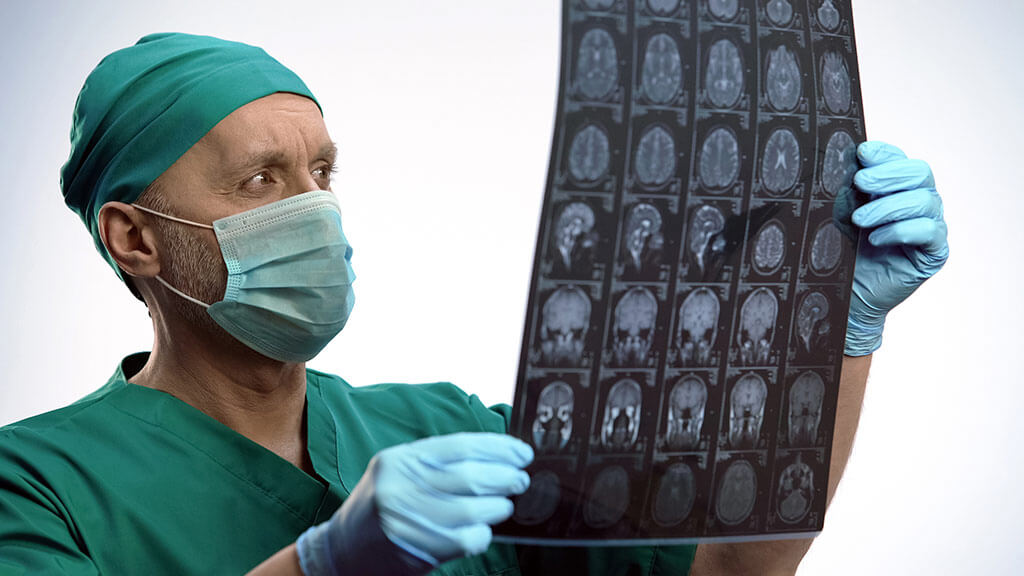Worldwide, the health community pays special attention to the development of innovative neurosurgical techniques since general brain tumor incidence reaches 20 per 100,000 persons. In addition, malignant tumors count up to one-third of this amount.
Treating brain tumors requires the best possible balance between completely removing tumor cells and saving healthy brain tissue. Beyond all doubt, there are numerous peculiarities (e.g., type of the tumor, general state of health, age of a patient, etc.) that influence treatment option choice. Nevertheless, being aware of common treatment principles and mechanisms is extremely helpful in conscious decision-making together with neurosurgeons or medical oncologists. Understanding the whole situation will let you stay calm and confident during each stage of the treatment course and, finally, successfully fight the disease.
Content
- When is the brain tumor surgical treatment performed?
- How should I get prepared for the brain tumor intervention?
- How will the surgeon get to the brain tumor?
- Which types of surgical intervention can be performed for brain tumors?
- What should I expect once the surgery for brain tumor is over?
- Where is it better to undergo neurosurgical treatment for brain tumors?
- Organization of brain tumor treatment abroad
When is the brain tumor surgical treatment performed?
Surgical intervention is the most widespread and effective way of brain tumor treatment.
Actually, there are three possible ways of doctor`s recommendations after revealing the tumor on the CT or MRI scans:
- Watchful waiting.In case the tumor is small, grows slowly, doesn`t have signs of malignancy, and doesn`t cause any life-threatening symptoms (often – totally asymptomatic), it is better to postpone active treatment. Each neurosurgical intervention is connected with certain health risks; when possible risks outweigh the possible benefits of removing the tumor, then a doctor chooses watchful waiting. For example, such an approach is suitable for revealing pituitary tumors or pineocytoma. Regular MRI performance will allow for assessing the dynamics of tumor growth and adjusting the treatment scheme timely.
- Surgical intervention. Primarily, the operation is performed when it is possible to remove the whole tumor. The main types of tumors that usually require surgical treatment include gliomas, meningiomas, medulloblastomas, craniopharyngiomas, acoustic neuromas, and primitive neuroectodermal tumors. There are numerous additional indications for performing surgery, and we will discuss all of them further.
- Reducing the total volume of a tumor by means of radiation therapy. Sometimes the tumor is too big to be removed during one surgical intervention, or it can be located near vital brain centers. In such cases, it is reasonable to perform a course of radiation therapy, which will damage the tumor`s structure and impair its ability to grow. A shrunken tumor can be successfully treated during the subsequent surgical intervention.
As mentioned above, the possibilities of the surgical intervention are not restricted to removing the whole tumor.
Other indications for the neurosurgery include the following:
- Obtaining material (part of the tumor tissue) for further histological examination and detecting the type of the tumor more precisely. Such information is essential for confirming the diagnosis, elaborating the treatment plan, and determining the prognosis.
- Partial removal of the tumor in order to alleviate neurological symptoms connected with high intracranial pressure. Each tumor has a certain volume, while the total volume of the skull is limited. That is why growing tumor causes gradual compression of the brain tissue and deterioration of its functions.
- Restoring the normal flow of the cerebrospinal fluid that is often blocked by the tumor mass.
- Delivering to the brain devices for internal chemotherapy or radiation therapy.
- Delivering to the brain devices for intra-surgical treatment, namely, laser surgery.
Sometimes surgery requires preliminary preparation pointed at improving the general state of a patient. This includes administering anticonvulsant drugs to cope with seizures or glucocorticosteroids to reduce brain edema.
We will discuss important aspects of preparation for the intervention of any type in the next paragraph.
How should I get prepared for the brain tumor intervention?
This thought can become surprising for you, but getting ready for neurosurgery includes not only medical issues. Your sense of well-being will change for a certain period, and it is better to consider all tricky moments in advance once you have such a chance. When you undergo surgical intervention as a part of a watchful waiting approach, it is usually planned in few months. This is quite good for you since you have enough time to clarify all important questions with your doctor and get used to the thought of having brain surgery.
Meanwhile, one month period before the brain surgery is a great time for preliminary preparation:
- Arrange your working schedule – receive approval for the vacation and delegate all important tasks to competent colleagues.
- Consider a babysitter if you have children or a nurse / social worker if you take care of elderly relatives. You will continue to tend about beloved people, but save some time for yourself.
- Take a close look at household chores. If you don`t have any wish to cope with them before admission to the neurosurgical department, then it is improbable that you`ll want to do this afterward.
- Think about the content of your fridge – you can cook and freeze some tasty food in advance or ask friends and relatives to help you with this after the discharge from the hospital.
- Organize your leisure. You can prepare a wish list of books and movies or choose any online education course if you are ready to work up your skills, even during the recovery period. You can also prepare for oncoming holidays and birthdays – buy cards and presents and be ready to send them.
One week period before the brain surgery brings new activities:
- You will see your doctor. During the appointment, you should feel free to ask all questions that can bring anxiety to your mind.
- You will undergo preoperative examination, namely, blood tests, ECG, and MRI.
- You will communicate with an anesthesiology specialist, who will provide you with the best possible anesthesia during the intervention. Don`t forget to tell a doctor about all medications you are taking currently and on a long-term basis.
- Check once more insurance documentation and recommendations from your insurance company, if there are any.
- Prepare everything necessary for staying in the hospital – prescription drugs, glasses and hearing aids, clothes, and something to make your free time more pleasant and interesting.
On the day of the brain surgery, or a day before it, you will be admitted to the hospital. It is better to leave jewelry at home, and remove contact lenses, make up and nail polish. All your further actions will be guided by healthcare professionals. After changing your clothes and putting on a surgical gown, you will be given premedication, which has sedative action and will help you to relax. Later, in the operating room, you will receive general anesthesia and fall asleep till the end of the intervention. Afterward, you will be moved to the intensive care unit (ICU) or recovery. Healthcare professionals will inform your family and friends about your current state before they are able to visit you.
How will the surgeon get to the brain tumor?
Delicate brain tissue is effectively protected from external damage by cranial bones (the skull). This is excellent in normal conditions but significantly hampers the performing of neurosurgical interventions. Thus, the first stage of most operations includes craniotomy – the temporary removing part of the skull (bone flap) to provide access to the brain tissue.
Depending on the localization and size of a tumor, neurosurgeons choose the most appropriate type of craniotomy from the following ones.
- Extended bifrontal craniotomy is an invasive approach that is used to reach large or difficult tumors in the frontal part of the brain. A surgeon makes an incision behind the hairline, so the whole bone part of the forehead can be removed. This approach gives preference to removing extra bone than damaging healthy brain tissue on the way to a tumor. An extended bifrontal craniotomy is mainly performed during the treatment of malignant skull base tumors, meningiomas, and neuroblastomas.
- ”Eyebrow” craniotomy or supra-orbital craniotomy is a kind of intermediate approach between an extensive craniotomy and endonasal endoscopic surgery. This type of craniotomy requires only a small, virtually invisible incision within the eyebrow. Supra-orbital craniotomy provides much faster recovery than open craniotomy and is performed during the treatment of skull base tumors, Rathke's cleft cysts, and certain pituitary tumors.
- ”Keyhole” craniotomy or retro-sigmoid craniotomy is a minimally invasive surgical approach. In applying this technique, the incision is made behind the ear, which allows accessing the cerebellum and brainstem. Retro-sigmoid craniotomy also provides fast recovery, minimal pain, and scar formation. This approach is used during the treatment of skull base tumors, acoustic neuromas, meningiomas, and even metastatic brain tumors.
- Orbitozygomatic craniotomy is an extensive and traumatic approach, which is used when minimally invasive ones are not sufficient for removing complex brain lesions. A surgeon makes an incision behind the hairline and temporarily removes the bone part of the cheek up to the margin of the orbit. Such manipulation provides access to deeper parts of the brain, simultaneously avoiding unnecessary damage to the healthy brain tissue. Orbitozygomatic craniotomy is highly effective for the treatment of craniopharyngiomas, meningiomas, and pituitary tumors. Bone defects are fixed at the end of the intervention by means of plastic surgery.
- Translabyrinthine craniotomy is a complex approach that is mainly used for the treatment of acoustic neuroma (vestibular schwannoma). This technique includes making an incision behind the ear and removing the mastoid bone, including a certain part of the inner ear bone. Removing these structures causes complete hearing loss; that is why it is performed only in patients with absent hearing or a high risk of severe complications in choosing other approaches. Despite its invasiveness, translabyrinthine craniotomy significantly reduces the risk of facial nerve injury.
- Endoscopic techniques provide a decent option for craniotomy and open surgical interventions. This type of approach includes removing a tumor or taking a biopsy through the mouth or nose (endonasal endoscopic surgery) or small holes in the skull (neuroendoscopy), as well. Endoscopic techniques combine the possibility of accessing remote and hard-to-reach areas of the brain with minimal invasiveness and preserving healthy brain tissue. Brain tumors that are suitable for the treatment by means of endoscopy include skull base tumors, pineal region tumors, pituitary tumors, Rathke's cleft cysts, and ventricular tumors. It should be mentioned that this approach requires the special qualification of a neurosurgeon, as not all doctors are skilled enough to work with endoscopic equipment. Naturally, a healthcare institution should have a decent technical base in order to offer this approach.
Which types of surgical intervention can be performed for brain tumors?
As mentioned before, surgical interventions can pursue different aims, from receiving tissue samples for the histological examination to removing the entire tumor mass. You will discuss all the available options with your treating physician and choose the most appropriate one. Generally speaking, all surgical interventions can be divided into the following groups.
Radical surgical interventions imply the total removal of the tumor and suspicious tissues. State-of-art advances in the field of neurosurgery provide specialists with the most intricate instruments for performing complicated operations. First of all, brain mapping technology allows revealing all the important functional pathways and vital centers near the tumor. Thus, a surgeon performs an operation confidently, reducing the risk of causing severe neurological deficits (like sensory loss, motor deficit, dysarthria, dysphagia, etc.) in the postoperative period. Stereotactic surgical techniques with high-resolution 3D images of the brain provide a specialist with additional information about the localization of the tumor. Finally, using precise, innovative equipment, namely, the Visualase system for the MRI-guided laser ablation and the Tubular Retractor System for the direct tumor removal, completes the whole picture of successful radical neurosurgical intervention.
Palliative surgical interventions are performed in order to reduce the volume of too large tumors before further radiation therapy or chemotherapy or to relieve life-threatening symptoms of the tumor presence. This kind of procedure is mainly carried out in patients with inoperable tumors, which can be due to tumor characteristics or the general state of a person. The most widespread palliative interventions include shunt surgeries, aimed to remove the excessive amount of cerebrospinal fluid from the brain, and decompression trepanation, aimed to lower high intracranial pressure. Depending on the clinical situation, manipulations can be performed via both open and laparoscopic approaches.
Complex surgical interventions combine the advantages of surgical procedures with the application of additional treatment methods. We should pay special attention to the following ones:
- Brachytherapy is an internal radiation therapy that uses the principle of stereotactic surgery for the precise implantation of irradiation sources in the brain tissue during the surgical intervention. This technique delivers high doses of radiation directly to the tumor and can be used as a primary treatment, adjuvant therapy, or anti-relapse measure.
- Chemotherapy can also be performed by means of surgical intervention. A surgeon may implant special gel wafers with appropriate drugs in the brain tissue. Once a wafer dissolves, the drug is released directly to the necessary part of the brain and starts killing oncologic cells. Another effective procedure from this group is the implantation of ventricular access devices (VAD). The device is placed under the skin of the skull and provides direct access to the inner part of the brain`s ventricles. Thus, it becomes possible to deliver medications directly into the cerebrospinal fluid or take out an excessive amount of fluid to prevent hydrocephaly.
What should I expect once the brain tumor surgery is over?
Undergoing surgery is an important first step on the way to curing brain tumors. You will continue this journey side by side with your family, friends, and healthcare professionals. Right after the intervention, you will spend some time in the hospital – this can be few days in case of an endoscopic procedure or up to a week in case of performing an open craniotomy. At first, you will stay in the ICU in order to be under the careful control of specialists; after this, you will be transferred to the regular ward, where your family and friends will be able to visit you. During the first few days, you will restore the ability to sit and walk, go to the bathroom without assistance and fulfill basic activities of daily living. Usually, you will need to take painkillers, as the anesthetic is wearing off quickly.
After discharge from the hospital, if necessary, you will have several follow-up appointments with the neurosurgeon and related specialists (neurologist, endocrinologist, ENT specialist, ophthalmologist). Laboratory tests, control MRI and thorough neurological examination will provide your doctor with all the information about your general state, presence of possible complications, and the recovery progress. The neurosurgeon will guide you through the long-term follow-up and recommend all necessary examinations. With time you will visit the doctor more rarely.
In some instances, you will have some limitations in physical activity. For example, performing neuroendoscopy makes it possible to return to the light forms of physical activity, like jogging or swimming, in few weeks. Patients after the open craniotomy are allowed to have long walks but should restrict heavy exercise load for few months. Some patients can find it helpful to have a course of physical therapy or go through a comprehensive neurological rehabilitation program.
Where is it better to undergo neurosurgical treatment for brain tumors?
When a brain tumor diagnosis is confirmed, and surgical treatment is recommended, we face multiple alternatives regarding the choice of the hospital and neurosurgeon. Making the right decision is crucial, as it contributes much to the final result of therapy. Careful investigation of the related information often leads us to the option of receiving treatment abroad, especially when our native country has low medical potential. Fortunately, many foreign countries are ready to help international patients even in the most complicated clinical situations. Choosing a hospital and doctor worldwide is totally possible nowadays.
In addition to the quality of treatment, the financial aspect is also significant to many patients. When performing an operation to remove a brain tumor, the cost depends on the kind of surgical intervention. Average costs are as follows:
- Surgical resection of brain tumor – €24,243
- Non-invasive removal of neoplasms with the Cyberknife system – €38,800
- Non-invasive removal of neoplasms with the Gamma knife system – €16,140
- MRI-guided laser ablation – €88,800
- Neurological rehabilitation after completion of the main course of treatment – €1,160 per day
Treatment in Germany can be more expensive compared to hospitals in developing countries. Nevertheless, most people prefer to undergo surgery in Germany if they have the necessary funds, as their lives depend on the quality of the operation.
Leading hospitals that offer treatment of brain neoplasms are:
- University Hospital Frankfurt am Main, Department of Adult and Pediatric Neurosurgery
- University Hospital Muenster, Department of Neurosurgery
- Charite University Hospital Berlin, Department of Adult and Pediatric Neurosurgery
- Beta Klinik Bonn, Department of Neurosurgery and Interventional Neuroradiology
- University Hospital Freiburg, Department of Adult and Pediatric Neurosurgery
Organization of brain tumor treatment abroad
When arranging treatment abroad, especially if it is your first experience in this field, the help of the company Booking Health becomes really significant. Booking Health is a medical tourism company that annually assists thousands of patients with brain tumors in undergoing the most up-to-date and professional surgical treatment. The most intricate details of the patient`s clinical state required treatment, necessary documentation, and travel issues are always taken into consideration. The company corresponds to the highest international standards.
Booking Health provides help in such significant aspects as:
- Recommending the best doctor and clinic for your case
- Booking an appointment on the convenient date
- Organizing comprehensive preoperative examination and choosing the most appropriate surgical intervention based on its results
- Providing you with a transfer, interpreter, and medical coordinator, if necessary
- Preparing for you all the medical reports and further recommendations
- Issuing medical insurance in case of complications during the treatment (amount of coverage is 200 000 euros)
- Providing help in further neurological rehabilitation, if necessary
- Providing help in further communication with your treating physician
The first step to undergoing successful neurosurgical intervention in the most appropriate clinic worldwide is leaving the medical request on the website of Booking Health. Our patient case manager or medical advisor will contact you the same day to discuss all the details and guide your further steps. Our specialists take pleasure in helping patients from different countries to improve and maintain their health.
Choose treatment abroad and you will for sure get the best results!
Authors:
This article was edited by medical experts, board-certified doctors Dr. Nadezhda Ivanisova, and Dr. Bohdan Mykhalniuk. For the treatment of the conditions referred to in the article, you must consult a doctor; the information in the article is not intended for self-medication!
Our editorial policy, which details our commitment to accuracy and transparency, is available here. Click this link to review our policies.
Sources:
Read:
Why Booking Health - questions and answers
How to make right decision when choosing the clinic and specialist
7 reasons to trust to the rating of clinics on the Booking Health portal
Don't know where to start?
Contact Booking Health







